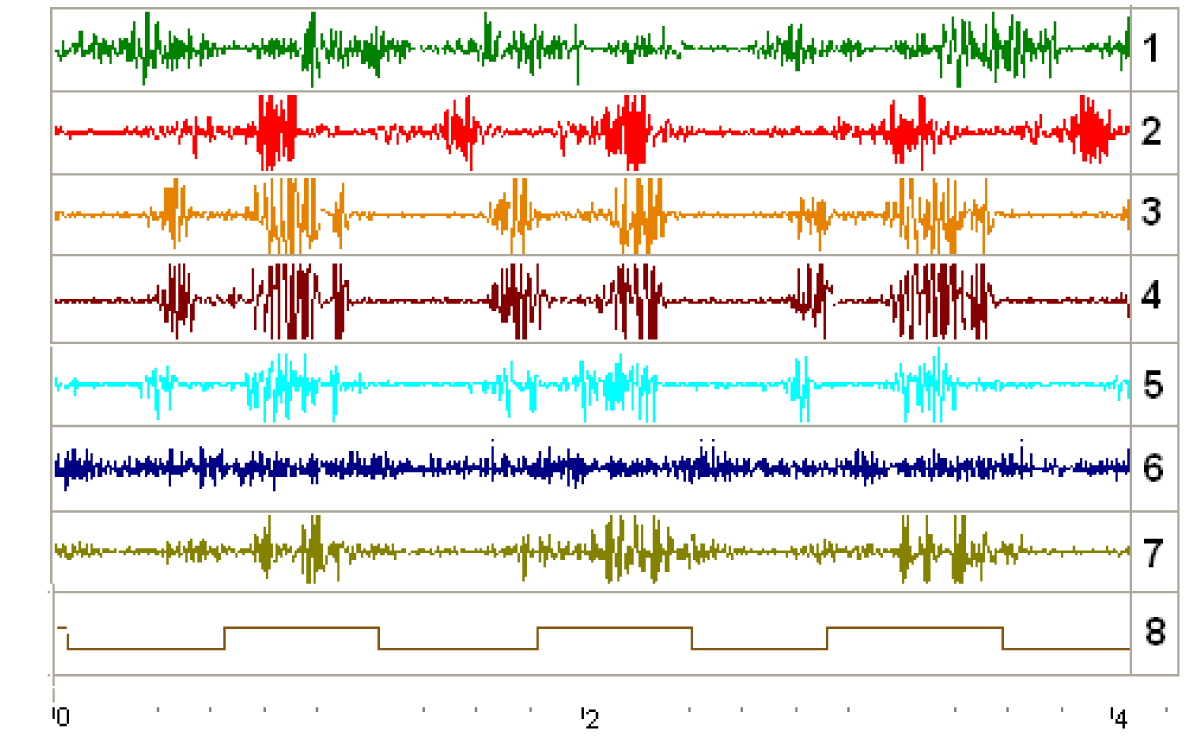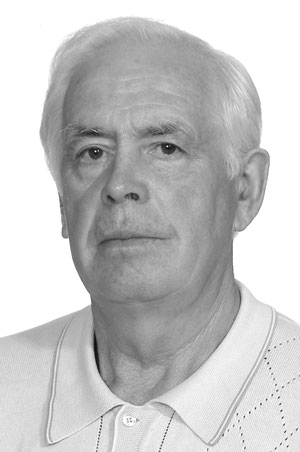Peculiarities of Electrical Activity of Muscles when Roller Skiing in Different Ways
Фотографии:
ˑ:
V.M. Senchenko, professor, Ph.D.
A.S. Gusev
I.A. Filina, Ph.D.
R.M. Gorodnichev, professor, Dr.Biol.
Velikie Luki State Academy of Physical Culture and Sport, Velikie Luki
Keywords: cross country skiers, speed and strength skill levels, electrical activity of muscles, skate skiing, classic skiing.
Speed-strength training sessions can be conducted more efficiently provided available accurate knowledge of the magnitude of efforts exerted by the working muscles while both skiing and roller skiing. The force of muscle contraction can be estimated by the intensity of the electrical activity. The purpose of the present research was to study the electrical activity of muscles (EAM) when roller skiing using classic and freestyle techniques at different speed. The EAM was registered in 7 cross country skiers while they were covering a standard distance (50 meters) on roller skis at maximum and distance speed. The electrical activity of the following muscles was registered: biceps and triceps brachii muscles; vastus lateralis, vastus medialis and biceps femoris muscle; gastrocnemius and tibialis anterior muscle. The names of the muscles are brought in line with the current International Anatomical Terminology. It was found that during roller skiing at maximum speed using the classic technique, the shoulder muscles and the gastrocnemius muscle were proved to develop greater strength compared with skate skiing. Strength developed by the vastus lateralis and the biceps femoris muscle, the tibialis anterior muscle is much the same when skiing in both ways. The vastus medialis developed less strength compared with freestyle skiing. While moving at distance speed, the efforts of the shoulder muscles and the biceps femoris muscles were also higher, and that of the vastus medialis - less than in case of classic skiing. Therefore, there are characteristic features of the muscle efforts when roller skiing at different speed using skate and classic techniques.
Introduction. Speed and strength skill levels of cross country skiers are considered especially important in the today's training process. We believe that speed-strength training sessions can be conducted more efficiently if knowing exactly the magnitude of efforts exerted by the working muscles while skiing and roller skiing. At the moment we have information only about the vertical and horizontal components of the efforts being made directly to the ski itself [3]. It is clear that such efforts are provided by the contraction in a number of skeletal muscles and do not contain any information about the strength of reducing of specific muscles involved in the movement. It is known that the force of contraction of skeletal muscle can be determined by the intensity of electrical activity at the time of contraction [2]. In this regard, the purpose of our research was to study the electrical activity of muscles (EAM) when roller skiing using classic and freestyle techniques at different speed.
Materials and methods. The research involved 7 students (cross country skiers, 2 - 1 Class). They all gave a written consent to take part in the experiment, which was affirmatively authorized by the Bioethics Committee of Velikie Luki State Academy of Physical Culture and Sport and complied with the Declaration of Helsinki. All the subjects skied a 150m distance over an asphalt road surface, which was divided into 3 zones: starting stride (distance was determined on an individual basis), zone of registration of the test indices (50 meters), braking zone. The roller skis Start Skating 71 were used for skate skiing and Pro-ski Classic C2 - for classic skiing. At the beginning, the subjects skied the distance thrice at maximum speed using the skate technique, after that thrice - at distance speed (90% of maximum). Upon changing roller skis the skiers covered the distance zone using classic technique under similar conditions. In both cases, the V1 skate technique was used while moving.
The electrobiological activity of muscles was registered in all the subjects, while they were covering the distance, using a 16-channel electromyograph "MegaWin МЕ 6000" (Finland). The received data were processed using the special software application "MegaWin". The electrical activity of the next 7 muscles was extracted: biceps and triceps brachii muscles; vastus lateralis, vastus medialis and biceps femoris muscle; gastrocnemius and tibialis anterior muscle. The names of the skeletal muscles mentioned in this paper are brought in line with the current International Anatomical Terminology [1]. The electrical activity of the tested muscles was recorded using an eletromyograph at a considerable distance from the registering computer, the data were transferred on-line via Bluetooth. The signal sampling frequency amounted to 1000 Hz. We used disposable surface disk electrodes, the diameter of the electrically conductive surface equaled 0.9 cm. The active electrode was placed over the tested myogaster (the projection of the motor point), the reference one - along its fibers with 2cm interelectrode distance, the grounding electrode was placed at each tested muscle. An example of the recording of the electrical activity of muscles while roller skiing is given in Figure 1.

Fig. 1. Electrical activity of the skeletal muscles on the right side of the body while roller skiing using freestyle technique
Note: 1 – biceps brachii muscle; 2 – triceps brachii muscle; 3 – vastus lateralis; 4 – vastus medialis; 5 – biceps femoris muscle; 6 – gastrocnemius muscle 7 – tibialis anterior muscle; 8 – synchronization channel of the support phase of the right leg.
The beginning of each step was determined by means of a tensometer, which was placed under the weight-bearing area of the foot. The statistical data was processed using a standard software package.
Results and discussion. According to the analysis of the findings, while roller skiing at maximum speed using the skate technique, the highest electrobiological activity was registered in the vastus medialis, and the lowest one - in the biceps brachii muscle (Table 1). Relatively high EAM values were observed in the biceps femoris muscle and the triceps brachii muscle.
Table 1. Bioelectrical activity (mcV*sec) of muscles while roller skiing, М±m
|
Muscles |
Maximum speed |
Distance speed |
||
|
Freestyle |
Classic |
Freestyle |
Classic |
|
|
Biceps brachii muscle |
54,6±1,5 |
86,5±2,4* |
50,7±1,4*** |
53,3±1,6** |
|
Triceps brachii muscle |
144,7±1,9 |
196,3±3,3* |
137,3±5,8*** |
191,5±6,1 |
|
Vastus lateralis |
81,9±1,2 |
80,6±1,5 |
83,3±0,9 |
80,5±3,1 |
|
Vastus medialis |
160,3±3,6 |
129,7±2,8* |
140,2±2,3*** |
108,3±3,8 |
|
Biceps femoris muscle |
149,6±4,6 |
176,9±8,1 |
143,5±3,8*** |
169,2±5,1 |
|
Gastrocnemius muscle |
56,1±1,2 |
60,4±1,1* |
57,2±2,1 |
57,3±1,1 |
|
Tibialis anterior muscle |
105,7±2,1 |
105,1±0,6 |
105,1±3,8*** |
78,4±1,8** |
Note: Significance of differences (p<0.05): * - classic skiing from freestyle at maximum speed; ** - classic skiing at different speed; *** - freestyle from classic skiing at distance speed
When roller skiing at the same speed using the classic technique, the integrative electrical activity increased statistically significantly in the tested shoulder muscles and the gastrocnemius muscle, and it slightly changed in the vastus lateralis and the tibialis anterior muscle (Table 1). The electrical activity of the vastus medialis, on the contrary, was lower by 19.1% (p<0.05). In the biceps femoris muscle the integrative EAM did not change statistically significantly. Therefore, while roller skiing at maximum speed using the traditional technique the shoulder muscles and the gastrocnemius muscle develop higher strength compared with skate skiing. Strength developed by the vastus lateralis, biceps femoris muscles and tibialis anterior muscles is much the same when skiing in both ways. Only one of the tested muscles - the vastus medialis developed less strength compared with freestyle skiing. Probably, this fact is related to the structure, localization and functional role of the given muscle [1].
While covering a 50m distance at the speed of 90% of maximum speed using the freestyle technique, the electrical activity of the shoulder muscles and the vastus medialis decreased slightly, but this change was statistically insignificant (p>0.05). The electrical activity of the tested muscles slightly changed and by estimate remained at the level typical for maximum speed.
When classic technique was used at distance speed, the integrative electrical activity decreased significantly in the biceps brachii muscle and the tibialis anterior muscle as compared with the values registered at maximum speed (Table 1). In the rest of the muscles speed reduction did not influence the electrical activity rate. Therefore, speed reduction when roller skiing using the classic technique was accompanied by the decrease in the effort of two muscles - the biceps brachii muscle and the tibialis anterior muscle.
The comparative analysis of the electrical activity of muscles while roller skiing at distance speed using skate or classic techniques revealed that, just as in case of moving at maximum speed, while using the classic technique when skiing the electrical activity of the shoulder muscles and the biceps femoris muscles was higher, and of the vastus medialis - lower. The characteristic feature of moving at distance speed was that the tibialis anterior muscle was less active than while moving at maximum speed (Table 1). Consequently, when covering a 50m distance using the classic technique at the speed of 90% of maximum, the shoulder muscles and the biceps femoris muscles develop more strength than in case of the freestyle technique. Two muscles - the vastus medialis and tibialis anterior muscles develop less effort when the classic technique is used (Table 1).
The detected peculiarities of changes in the electrical activity of muscles while roller skiing using different techniques at different speed are not surprising. They reflect the corresponding redevelopment of the efforts exerted by the working muscles, the dynamic and kinematic characteristics typical for particular motor activity features [4,5].
Conclusion. Thanks to registering the electrical activity of skiers' muscles when roller skiing efforts developed by the muscles can be estimated. The specificity of the manifestation of muscle efforts depends on the technique and speed of movement. Knowledge of the efforts exerted by specific muscles can be used when planning training sessions aimed at improving speed-strength skills of cross country skiers.
References
- Vorob’yev, V.P. Big human anatomy charts / V.P. Vorob’yev. – Monograph: Harvest, 2003. – 1312 P. (In Russian)
- Gorodnichev, R.M. Sport electroneuromyography: monograph / R.M. Gorodnichev. – Velikie Luki, 2005. – 229 P. (In Russian)
- Gursky, A.V. Improving technical skills of cross country skiers on the basis of model characteristics of motor activity / L.F. Kobzeva, L.A. Gurskaya // Proceedings of the II All-Rus. scient. conf. of cross country skiing trainers. May 12-15 2013. – Smolensk. – P. 70–87. (In Russian)
- Gurfinkel', V.S. Central programs and variety of movements / V.S. Gurfinkel, Yu.S. Levick // Motion control. – Мoscow: Nauka, 1990. – P. 32–41. (In Russian)
- Platonov, V.N. The system of training athletes in Olympic sports / V.N. Platonov. - Kiev: Olimpiyskaya literatura, 2004. – 807 P. (In Russian)
Corresponding author: gorodnichev@vlgafc.ru



